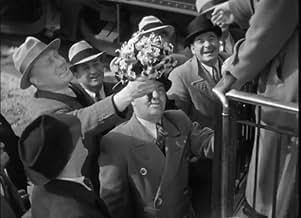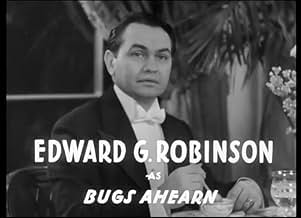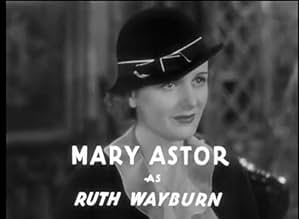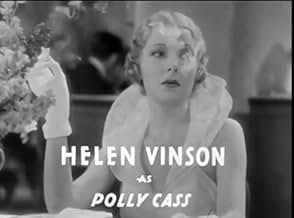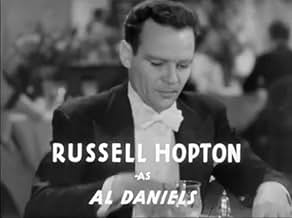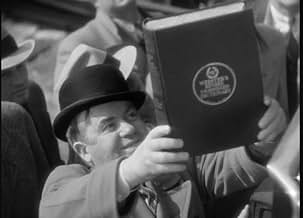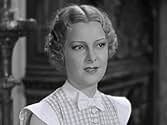IMDb रेटिंग
7.0/10
1.5 हज़ार
आपकी रेटिंग
अपनी भाषा में प्लॉट जोड़ेंWhen Prohibition ends, a beer baron sees the writing on the wall, quits the rackets, and tries to break into California society.When Prohibition ends, a beer baron sees the writing on the wall, quits the rackets, and tries to break into California society.When Prohibition ends, a beer baron sees the writing on the wall, quits the rackets, and tries to break into California society.
- पुरस्कार
- कुल 2 जीत
Don Dillaway
- Gordon Cass
- (as Donald Dillaway)
Loretta Andrews
- Society Girl
- (बिना क्रेडिट के)
Bonnie Bannon
- Society Girl
- (बिना क्रेडिट के)
Joan Barclay
- Society Girl
- (बिना क्रेडिट के)
Max Barwyn
- Headwaiter
- (बिना क्रेडिट के)
Sidney Bracey
- Butler
- (बिना क्रेडिट के)
Harry C. Bradley
- Harry S. Winter
- (बिना क्रेडिट के)
Lynn Browning
- Society Girl
- (बिना क्रेडिट के)
Joe Caits
- One of Bugs' Mugs
- (बिना क्रेडिट के)
Maxine Cantway
- Society Girl
- (बिना क्रेडिट के)
फ़ीचर्ड समीक्षाएं
Prohibition ends and gangster boss Bugsy Ahearn, like so many during the depression, finds himself unemployed. What to do? Fortunately, he has laid aside much of his ill-gotten gains and has no money worries. So he decides to improve himself, to acquire some culture and move in elite circles. And therein lies a very funny story.
Edward G. Robinson shows a flair for comedy and shows off some of his immense talent as a social climber who decides to shoot the moon. He moves from Chicago to the West Coast, buys a mansion and falls for a lady from a family of swindlers, and generally falls into a series of mishaps, each one funnier than the last. He gets excellent support from Mary Astor, who becomes his guide to the finer points of becoming 'quality'.
You will gain great respect for Robinson if you've only seen him in tough-guy roles, as he carries the picture as a society naif in this written-for-the-screen comedy. There are no dead spots, either, as the story moves along briskly in an enjoyable 75 minutes. It was shown at Cinefest, Columbus, O., 6/13.
Edward G. Robinson shows a flair for comedy and shows off some of his immense talent as a social climber who decides to shoot the moon. He moves from Chicago to the West Coast, buys a mansion and falls for a lady from a family of swindlers, and generally falls into a series of mishaps, each one funnier than the last. He gets excellent support from Mary Astor, who becomes his guide to the finer points of becoming 'quality'.
You will gain great respect for Robinson if you've only seen him in tough-guy roles, as he carries the picture as a society naif in this written-for-the-screen comedy. There are no dead spots, either, as the story moves along briskly in an enjoyable 75 minutes. It was shown at Cinefest, Columbus, O., 6/13.
And yet it is in one of the Warner Gangster DVD packs. This is one of those bizarre results from the whipsaw of events - age of DVD, great recession and resulting death of DVD, economic recovery and age of Blu and streaming -that put this relatively obscure film on DVD but leaves the three Show Boat films unrestored and in the Warner Archive. But I digress.
It may be obscure, but it is definitely worth your time. This is a comedy about a gangster, not a gangster film, as I said in my title. Robinson plays Bugs Ahearne, a Chicago gangster at the time of Roosevelt's 1932 election and, by extension, the death of prohibition. Ahearne is wise in that he sees the age of the mob and easy money from bootleg liquor is over, and divides his profits among his gang. Ahearne himself winds up with 1.25 million dollars. Multiply that by about 20 to get today's amount.
Ahearne has been planning for this day, and he has been reading the classics and improving himself. He plans to retire to California and become part of polite society. The problem is, outside of reading, Bugs has never talked to or known any society people in his life. Just like you can't learn to drive a car by just reading books, Bugs doesn't realize he sticks out like a sore thumb.
He also makes the mistaken calculation that people of "breeding" - whatever that is supposed to mean - and culture can be depended upon to be on the level, whether their motives are good or maybe not. Yet he is fooling the society people by pretending to be somebody else, wanting to leave his gangster roots behind. The result is an absolutely hilarious comedy of manners with tons of precode one liners, many of which I cannot repeat even in 2019.
And if you never thought Edward G. Robinson and Mary Astor could have great chemistry, maybe even be considered a comedy team, guess again. With great supporting performances. With a great understated performance by Russell Hopton as Robinson's best friend, who can't imagine life without the mob and tags along with "Bugs" for the ride. I guarantee you will never see polo as the same game again. Highly recommended.
It may be obscure, but it is definitely worth your time. This is a comedy about a gangster, not a gangster film, as I said in my title. Robinson plays Bugs Ahearne, a Chicago gangster at the time of Roosevelt's 1932 election and, by extension, the death of prohibition. Ahearne is wise in that he sees the age of the mob and easy money from bootleg liquor is over, and divides his profits among his gang. Ahearne himself winds up with 1.25 million dollars. Multiply that by about 20 to get today's amount.
Ahearne has been planning for this day, and he has been reading the classics and improving himself. He plans to retire to California and become part of polite society. The problem is, outside of reading, Bugs has never talked to or known any society people in his life. Just like you can't learn to drive a car by just reading books, Bugs doesn't realize he sticks out like a sore thumb.
He also makes the mistaken calculation that people of "breeding" - whatever that is supposed to mean - and culture can be depended upon to be on the level, whether their motives are good or maybe not. Yet he is fooling the society people by pretending to be somebody else, wanting to leave his gangster roots behind. The result is an absolutely hilarious comedy of manners with tons of precode one liners, many of which I cannot repeat even in 2019.
And if you never thought Edward G. Robinson and Mary Astor could have great chemistry, maybe even be considered a comedy team, guess again. With great supporting performances. With a great understated performance by Russell Hopton as Robinson's best friend, who can't imagine life without the mob and tags along with "Bugs" for the ride. I guarantee you will never see polo as the same game again. Highly recommended.
The Little Giant (1933) :
Brief Review -
The reason why I don't enjoy modern-day gangster comedies. Much better than Roy Del Ruth's own "Lady Killer," which tried the same theme in the same year. Today's gangster comedies hardly offer anything new and unique. All they do is just copy some good scenes from old Hollywood or British flicks and paste them on modern canvas with a new cast. That's the reason why I don't enjoy them as much as others do. I enjoy these original source materials instead. Roy Del Ruth was doing alright in the 30s, despite not making many great films. His Lady Killer has a similar theme drawn with James Cagney, while The Little Giant tells the same story again with new characters and a little bit more comedy and romance. It follows the attempts of an ex-gangster to make his way into high society, but he gets conned by a family of crooks. It was a pleasure seeing Edward G. Robinson in such a role where he could be brutal as well as funny at the same time. And he nailed it in both parts. Mary Astor's generous, smart little dame was bound to be loved by Bug, but why should he have all the fun? The audience found her just as lovable as him. You may hate Poly Cass' character, but you cannot hate Helen Vinson's portrayal. She looks like a perfect honey badger. The other cast members complement each other very well. The Little Giant is a very influential flick. Smartly written by Robert Lord and Wilson Mizner, this crime comedy has scenes that can never get outdated. You find many references in any modern-day gangster comedy, and you can immediately recall The Little Giant for its enormous contribution to top-class cliches. 9 decades old, yet our generation is remaking it. You can imagine how good it must have been for contemporary audiences. Roy Del Ruth may have lacked great classics in his career, but he certainly gave us many nice, entertaining, and timeless films. Hoping to catch more of his work soon.
RATING - 7.5/10*
By - #samthebestest.
The reason why I don't enjoy modern-day gangster comedies. Much better than Roy Del Ruth's own "Lady Killer," which tried the same theme in the same year. Today's gangster comedies hardly offer anything new and unique. All they do is just copy some good scenes from old Hollywood or British flicks and paste them on modern canvas with a new cast. That's the reason why I don't enjoy them as much as others do. I enjoy these original source materials instead. Roy Del Ruth was doing alright in the 30s, despite not making many great films. His Lady Killer has a similar theme drawn with James Cagney, while The Little Giant tells the same story again with new characters and a little bit more comedy and romance. It follows the attempts of an ex-gangster to make his way into high society, but he gets conned by a family of crooks. It was a pleasure seeing Edward G. Robinson in such a role where he could be brutal as well as funny at the same time. And he nailed it in both parts. Mary Astor's generous, smart little dame was bound to be loved by Bug, but why should he have all the fun? The audience found her just as lovable as him. You may hate Poly Cass' character, but you cannot hate Helen Vinson's portrayal. She looks like a perfect honey badger. The other cast members complement each other very well. The Little Giant is a very influential flick. Smartly written by Robert Lord and Wilson Mizner, this crime comedy has scenes that can never get outdated. You find many references in any modern-day gangster comedy, and you can immediately recall The Little Giant for its enormous contribution to top-class cliches. 9 decades old, yet our generation is remaking it. You can imagine how good it must have been for contemporary audiences. Roy Del Ruth may have lacked great classics in his career, but he certainly gave us many nice, entertaining, and timeless films. Hoping to catch more of his work soon.
RATING - 7.5/10*
By - #samthebestest.
Although the early sound era presented some problems - such as stationary camera shots with the actors nailed to their marks, and minimal use of background music resulting in long stretches of torpor - by 1931 most of these bugs had been corrected; thus the pre-censorship period of '31-'34 is chockfull of some of the most vigorous, creative and satisfying movies of Hollywood's Golden Age, however little-known many of them may be. LITTLE GIANT is one such hidden gem. A lightning-paced gangster comedy from the Warner-First National studio (where speed and economy were stylistic hallmarks), it's fast, funny and flippant in a manner that the decayed virgins of the Hays Office would render, if not impossible, at least awfully difficult after '34. Edward G Robinson plays Bugs Ahearn, a Chicago bootlegger put out of business by Prohibition's repeal, who decides to relocate to California and buy his way into society. Once there, he's immediately preyed upon by the type of 'respectable' vipers & parasites his background has left him ill-equipped to recognize, let alone fend off. This 'fish-out-of-water' comedy benefits greatly from a cheerfully amoral tone and a slew of zesty performances, not least of them Mary Astor's as a busted heiress who is the only non-hood here who's on the level. The mix of slapstick and rat-a-tat verbal comedy, coming at you at fast as it does, works very well, and nobody was better at this kind of hectic farce than the woefully-underrated Roy del Ruth, who was one of a number of sure & steady craftsmen who hit their peaks only under the Warners' aegis. In Del Ruth's case, the coming of the Code (and his subsequent move to MGM) proved to be disastrous: though he continued to direct till the late 50s, his post-Warners work was so drained of zest and inspiration that he is hardly remembered at all today. Even the auteurist crowd dismisses him as a competent hack. But do yourself a favor and seek out everything he did prior to 1935, and you'll be rewarded with a body of work that will surprise you with its cynical bite and confident staging. They play as well today as they did the day they opened. (Highly recommended, besides GIANT, are BLESSED EVENT, LADY KILLER, EMPLOYEES ENTRANCE & TAXI.)
Like every great First National picture, this one starts off quickly, with Edward G. Robinson in full, glorious gangster mode, speaking the classic language of the Prohibition movie gangsters, words like "mugs" and "rods" ornamenting his lines. But there is a twist here: Robinson (as "Bugs" Ahearn, the "Beer Baron"), is going to quit the illegal beer business (since Prohibition has ended), and go straight. In fact, Bugs has a dream: to become successful in high society.
The script is very fast paced and delightful, and in a couple of places, quite shocking, reminding us of how progressive pre-Code Hollywood could be; I almost fell out of my chair when Robinson's flunky and companion Al, when asked by Robinson whether he ever saw a painting like the one in his living room, responds with, "not since I stopped using cocaine"!! Another shocker comes later when Robinson refers to some slimy society people as "fags". Oh dear!
Robinson was an amazing actor. He constantly shifts back and forth between the know-it-all wiseguy bully, and a would be high society snob, who is very unsure of himself. This uncertain, unconfident Robinson, a tough guy who swallows his pride and grovels before his betters, is pleasing to see, and he does it very well. Perhaps one of the great Robinson scenes of all time is when Mary Astor seduces an unsuspecting EGR on a couch. Robinson plays it beautifully, as he has no idea that he is being seduced; and in a delightful moment, when Mary Astor has shyly moved away, sudden realization hits EGR as to what might have just happened. He turns to the camera, and I swear he makes exactly the kind of faces, registering surprise and possible comprehension to the audience, exactly as Oliver Hardy famously did a thousand times in his career. A priceless and lovely moment.
There are many satisfying moments in this film, and I highly recommend this. The early EG Robinson movies are gifts to be treasured, and this is one of the best.
The script is very fast paced and delightful, and in a couple of places, quite shocking, reminding us of how progressive pre-Code Hollywood could be; I almost fell out of my chair when Robinson's flunky and companion Al, when asked by Robinson whether he ever saw a painting like the one in his living room, responds with, "not since I stopped using cocaine"!! Another shocker comes later when Robinson refers to some slimy society people as "fags". Oh dear!
Robinson was an amazing actor. He constantly shifts back and forth between the know-it-all wiseguy bully, and a would be high society snob, who is very unsure of himself. This uncertain, unconfident Robinson, a tough guy who swallows his pride and grovels before his betters, is pleasing to see, and he does it very well. Perhaps one of the great Robinson scenes of all time is when Mary Astor seduces an unsuspecting EGR on a couch. Robinson plays it beautifully, as he has no idea that he is being seduced; and in a delightful moment, when Mary Astor has shyly moved away, sudden realization hits EGR as to what might have just happened. He turns to the camera, and I swear he makes exactly the kind of faces, registering surprise and possible comprehension to the audience, exactly as Oliver Hardy famously did a thousand times in his career. A priceless and lovely moment.
There are many satisfying moments in this film, and I highly recommend this. The early EG Robinson movies are gifts to be treasured, and this is one of the best.
क्या आपको पता है
- ट्रिविया"Al" recounts a job where he shot up a stuffed Polar Bear. The same plot scene was depicted in The Public Enemy (1931) with "Tom" doing the shooting.
- गूफ़The image of the single-engine plane carrying Ahern's "boys" appears empty except for the pilot.
- भाव
James Francis 'Bugs': The toughest mug in Chicago comes out here and gets trimmed by a lot of fags with handkerchiefs up their sleeves.
- कनेक्शनFeatured in Public Enemies: The Golden Age of the Gangster Film (2008)
- साउंडट्रैकChicago (That Toddlin' Town)
(1922) (uncredited)
Written by Fred Fisher
Played during the opening credits
Reprised when the gang comes to Santa Barbara
Reprised at the end
टॉप पसंद
रेटिंग देने के लिए साइन-इन करें और वैयक्तिकृत सुझावों के लिए वॉचलिस्ट करें
विवरण
- रिलीज़ की तारीख़
- कंट्री ऑफ़ ओरिजिन
- भाषाएं
- इस रूप में भी जाना जाता है
- Der kleine Gangsterkönig
- फ़िल्माने की जगहें
- Hotel Del Monte, मोंटेरे, कैलिफोर्निया, यूएसए(Polo field location)
- उत्पादन कंपनी
- IMDbPro पर और कंपनी क्रेडिट देखें
बॉक्स ऑफ़िस
- बजट
- $1,97,000(अनुमानित)
- चलने की अवधि1 घंटा 16 मिनट
- रंग
- ध्वनि मिश्रण
- पक्ष अनुपात
- 1.37 : 1
इस पेज में योगदान दें
किसी बदलाव का सुझाव दें या अनुपलब्ध कॉन्टेंट जोड़ें


